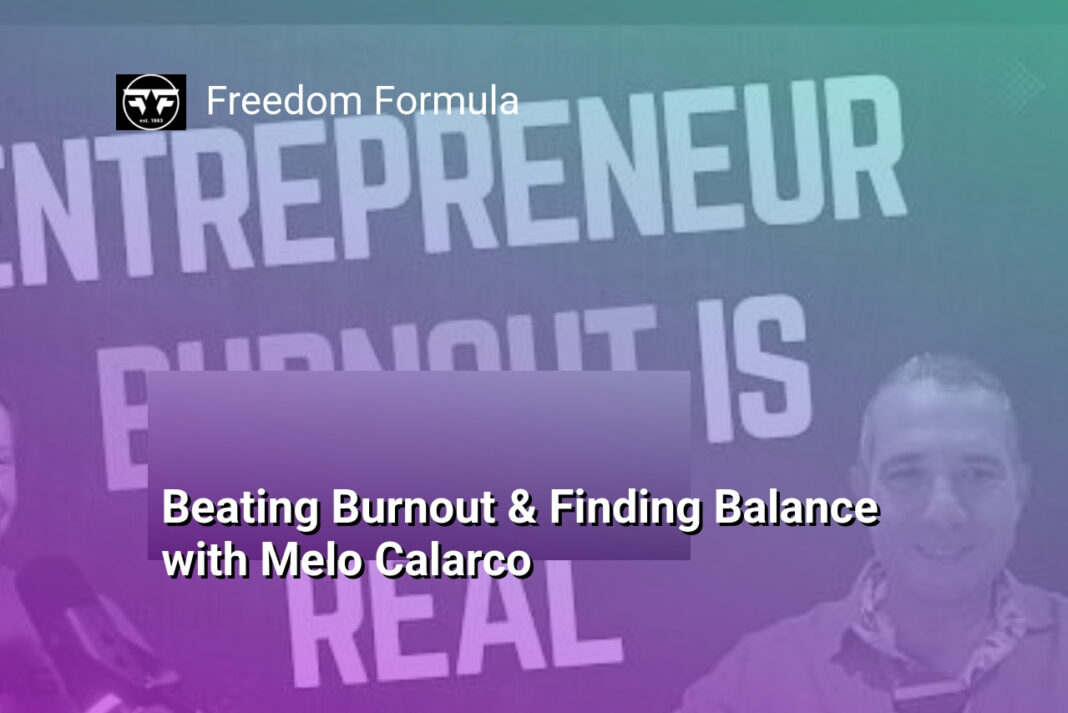The Bottom Line:
Here’s the summary in the requested format:
- I’ve learned that burnout is a cumulative process affecting high performers, characterized by extreme exhaustion, emotional detachment, and decreased work performance.
- Prioritizing self-care through consistent sleep, nutrition, exercise, and mental breaks is essential for maintaining professional and personal well-being.
- Implementing mindfulness techniques like short breathing exercises can help reset focus and manage stress effectively throughout the day.
- Regularly reconnecting with personal motivations and understanding the deeper purpose behind work can help sustain drive during challenging periods.
- Sharing knowledge and experiences globally can create meaningful impact, transcending traditional monetary goals and fostering personal and professional growth.
Understanding the Three Dimensions of Burnout
The Emotional Landscape of Professional Exhaustion
Burnout is a complex psychological phenomenon that extends far beyond simple workplace fatigue. At its core, it represents a profound state of emotional, physical, and mental depletion that systematically erodes an individual’s professional capabilities. The three interconnected dimensions of burnout create a comprehensive framework for understanding this pervasive challenge: exhaustion, detachment, and inefficacy.
Decoding the Exhaustion Mechanism
Exhaustion represents the foundational layer of burnout, characterized by an overwhelming sense of physical and emotional drain that transcends typical tiredness. Unlike normal fatigue, this state of depletion does not improve with standard rest or sleep. Professionals experiencing this dimension often report feeling perpetually tired, with energy reserves consistently running on empty. This chronic exhaustion manifests through persistent physical symptoms like headaches, muscle tension, and compromised immune responses, signaling a deeper systemic breakdown in personal resilience.
Psychological Disconnection and Professional Cynicism
Detachment emerges as the second critical dimension of burnout, representing a psychological defense mechanism where individuals emotionally distance themselves from work responsibilities. This dimension transforms passionate professionals into disengaged, cynical observers of their own professional landscape. Symptoms include a marked reduction in enthusiasm, increased skepticism about work’s meaning, and a growing sense of emotional numbness towards professional challenges. Detachment acts as a protective shield, preventing further emotional investment in an environment perceived as overwhelming or unrewarding.
The cumulative impact of these dimensions creates a self-reinforcing cycle where exhaustion breeds detachment, and detachment further diminishes professional efficacy. Understanding these intricate psychological mechanisms provides professionals with the first crucial step in recognizing and interrupting the burnout progression, enabling more targeted and effective intervention strategies.
Essential Self-Care Strategies for High Performers
Prioritizing Physical and Mental Restoration
High performers must recognize that sustainable success requires intentional recovery strategies. Physical restoration begins with strategic sleep management, targeting both quality and quantity. Aim for 7-9 hours of uninterrupted sleep, establishing consistent sleep-wake cycles that align with your natural circadian rhythms. Nutrition plays an equally critical role, focusing on whole foods that provide sustained energy and support cognitive function. Incorporate lean proteins, complex carbohydrates, and nutrient-dense vegetables to maintain optimal performance levels.
Designing Personalized Stress Management Protocols
Developing a customized stress management approach is crucial for preventing professional burnout. Implement daily mindfulness practices such as meditation, focused breathing exercises, or journaling to create mental space and process workplace challenges. Regular physical activity serves as a powerful stress mitigation tool, with activities like strength training, yoga, or cardiovascular exercise helping to release tension and reset mental frameworks. Consider tracking your stress markers through heart rate variability, sleep quality, and mood assessments to create data-driven interventions.
Establishing Boundaries and Renewal Practices
Creating clear professional boundaries is essential for long-term performance sustainability. Learn to communicate limits effectively, whether through strategic time blocking, selective commitment, or deliberate disconnection from digital platforms during personal time. Develop weekly and monthly renewal practices that allow complete mental and emotional reset, such as dedicated hobby time, nature immersion, or creative pursuits unrelated to professional responsibilities. These practices help maintain intrinsic motivation and prevent the emotional exhaustion characteristic of burnout syndrome.
Creating Sustainable Work-Life Balance Techniques
Designing Personalized Boundaries and Rhythms
Establishing sustainable work-life balance requires intentional boundary creation and personalized rhythm management. Professionals must recognize that balance isn’t a universal template but a customized approach tailored to individual needs, energy levels, and professional demands. This involves strategically mapping out work commitments, personal time, and recovery periods. Implementing clear demarcations between professional responsibilities and personal space helps prevent work from continuously encroaching on personal time. Techniques like designated work hours, digital communication cutoff times, and dedicated personal development windows can significantly reduce stress and prevent potential burnout scenarios.
Holistic Energy Management Strategies
Effective work-life balance transcends traditional time management and focuses on comprehensive energy management. This approach involves understanding personal energy cycles, recognizing peak productivity hours, and structuring work around these natural rhythms. Professionals should prioritize activities that replenish mental, emotional, and physical energy reserves. This might include incorporating regular exercise, practicing mindfulness techniques, maintaining consistent sleep patterns, and engaging in activities that provide genuine rejuvenation. By treating energy as a renewable resource and implementing strategic recovery mechanisms, individuals can maintain high performance while preventing exhaustion and emotional detachment.
Adaptive Resilience Planning
Creating sustainable work-life balance requires developing adaptive resilience frameworks that allow flexibility and continuous recalibration. This involves regularly assessing personal well-being indicators, monitoring stress levels, and proactively adjusting professional and personal commitments. Professionals should develop skills in recognizing early burnout signals, such as persistent fatigue, decreased motivation, or reduced task efficiency. Implementing periodic self-assessment checkpoints, maintaining open communication with supervisors about workload, and being willing to renegotiate responsibilities are critical components of this adaptive approach. By cultivating a dynamic and responsive relationship with work demands, individuals can maintain long-term professional sustainability and personal well-being.
Mindfulness and Mental Reset Practices
Cultivating Inner Calm Through Mindful Practices
Mindfulness represents a powerful strategy for mental reset and stress management. By intentionally focusing on the present moment, professionals can interrupt the cycle of chronic stress and prevent burnout. Breath-based techniques like the 90-second reset method allow individuals to recalibrate their nervous system, reducing physiological stress responses and enhancing cognitive clarity. These practices involve deliberate, deep breathing that activates the parasympathetic nervous system, promoting immediate relaxation and mental recalibration.
Strategic Mental Restoration Techniques
Implementing structured mental restoration techniques can significantly mitigate burnout risk. Meditation, even in short 5-10 minute intervals, can dramatically reduce cortisol levels and improve emotional regulation. Visualization exercises where professionals mentally rehearse successful scenarios or imagine peaceful environments can create psychological distance from stressors. Additionally, body scan techniques help individuals reconnect with physical sensations, interrupting negative thought patterns and promoting holistic awareness.
Integrating Mindfulness Into Professional Workflow
Successful mindfulness integration requires strategic implementation within professional environments. This involves creating micro-moments of reflection during workdays, such as mindful transitions between tasks, conscious breathing before meetings, or brief grounding exercises during high-pressure situations. Technology can support these practices through meditation apps, guided breathing programs, and digital wellness tools that remind professionals to pause and reset. By treating mindfulness as a skill to be developed rather than an optional luxury, individuals can build psychological resilience and maintain peak performance without succumbing to exhaustion.
Reconnecting with Professional Purpose and Motivation
Rediscovering Your Professional Passion
Professional burnout often stems from disconnection with one’s core motivations and purpose. To reignite passion, professionals must engage in deep introspection about their initial career aspirations and current trajectory. This involves critically examining the alignment between personal values and professional responsibilities. By reconnecting with the fundamental reasons that initially inspired your career choice, you can reestablish a sense of meaning and enthusiasm that transcends momentary challenges.
Strategic Motivation Realignment
Motivation is not a static construct but a dynamic energy that requires continuous nurturing. Professionals can strategically realign their motivation by setting meaningful, achievable goals that challenge and inspire them. This process involves breaking down larger career objectives into smaller, incremental milestones that provide regular opportunities for achievement and recognition. Additionally, creating a personal development roadmap that incorporates skill enhancement, networking opportunities, and potential career pivots can help maintain professional engagement and prevent stagnation.
Cultivating Professional Resilience
Resilience in professional contexts is built through intentional practices that strengthen emotional and psychological adaptability. This includes developing a growth mindset that views challenges as opportunities for learning and transformation. Professionals can enhance their resilience by actively seeking feedback, embracing continuous learning, and maintaining a flexible approach to career development. Implementing regular self-reflection practices, such as journaling or mentorship conversations, can provide valuable insights into personal growth patterns and potential areas for professional reinvention.
By systematically addressing motivational gaps, reconnecting with core professional purposes, and building robust psychological frameworks, individuals can effectively combat burnout and create sustainable, fulfilling career trajectories. The key lies in maintaining an active, intentional approach to professional development that prioritizes personal well-being and authentic engagement with one’s work.





